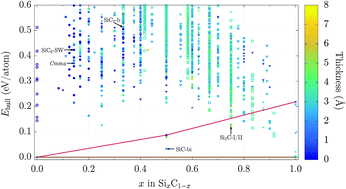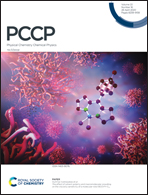Novel two-dimensional silicon–carbon binaries by crystal structure prediction†
Abstract
The semimetallic bandstructure of graphene and silicene limit their use in functional devices. Mixing silicon and carbon offers a rather unexplored pathway to build semiconducting sheets compatible with current Si-based electronics. We present here a complete theoretical study of the phase diagram of two-dimensional silicon–carbon binaries. To scan the composition range, we employ an ab initio global structural prediction method, complemented by exhaustive enumeration of two-dimensional structure prototypes. We find a wealth of two-dimensional low-energy structures, from standard honeycomb single- and double-layers, passing by dumbbell geometries, to carbon nanosheets bridged by Si atoms. Many of these phases depart from planarity, either through buckling, or by germinating three-dimensional networks with a mixture of sp2 and sp3 bonds. We further characterize the most interesting crystal structures, unveiling a large variety of electronic properties, that could be exploited to develop high-performance electronic devices at the nanoscale.

- This article is part of the themed collection: 2020 PCCP HOT Articles


 Please wait while we load your content...
Please wait while we load your content...